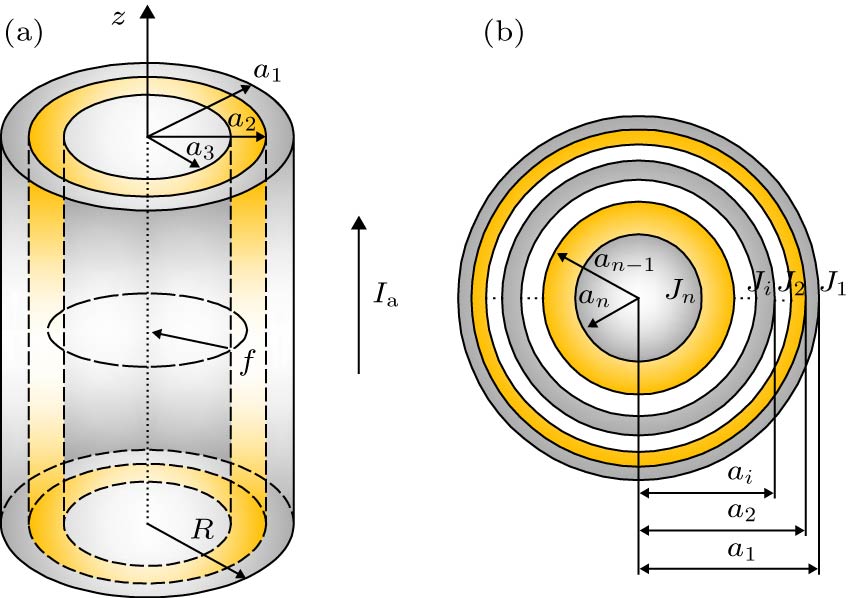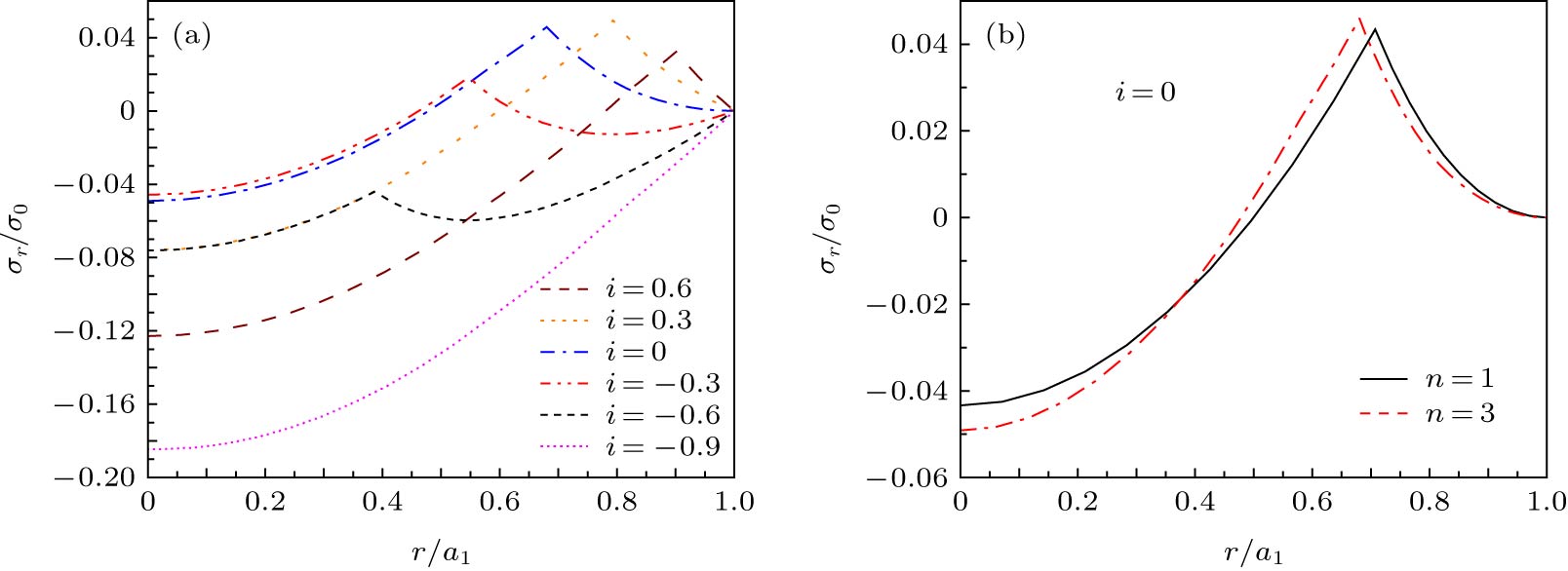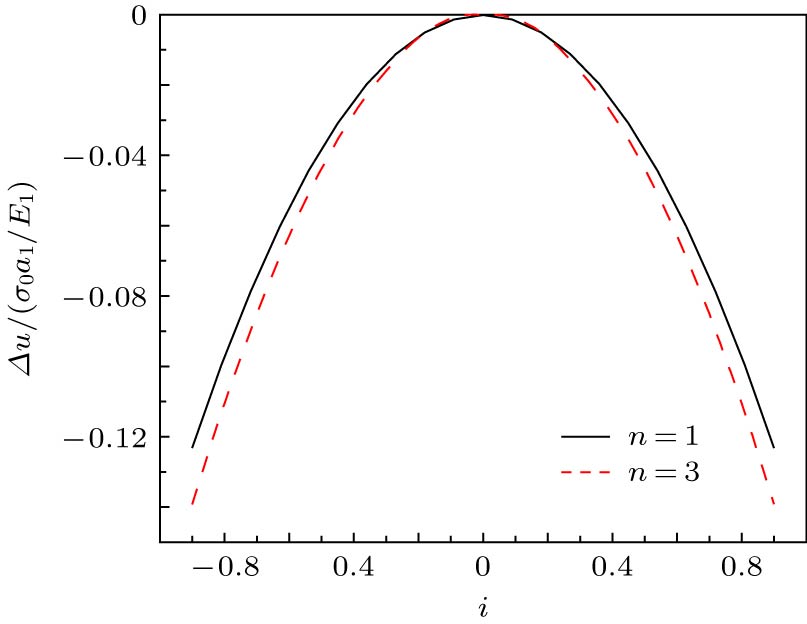-
High-temperature superconductor has high critical temperature, high transport current capacity and low energy consumption, which correspondingly offer the wide applications in the field of electric power. As an important concern, the mechanical properties of superconductor carried with transport current have received extensive attention. Still, its mechanical properties in various electromagnetic environments are under study. Most of previous studies are based on the assumption of uniform distribution of critical current density, and only few researches based on the non-uniform distribution of critical current density are carried out. In this work, the mechanical flux pinning response of cylindrical superconducting structures is studied. Considering the non-uniform features of critical current density along the radial direction, the distribution law of induced magnetic field and current for the cylindrical superconducting structure is obtained based on the Bean model. Combined with the plane strain method, the analytical expression of magnetic flux pinning force, stress and magnetostriction in the superconducting structure are obtained. The results show that the uneven distribution of critical current density causes the flux pinning force to change, which further leads the superconductor`s local radial stress to vary with the critical current density. When the transport current flowing through the superconductor is increased in the ascending field, the radial stress and the hoop stress both appear compressive. The non-uniform distribution of critical current density has no significant effect on the overall trend of the internal stress, but displays an obvious influence on the stress distribution, and the superconducting structure is compressed and deformed. The results are consistent with those in the uniform case. When the transport current decreases during field descending, the critical current starts to reverse from the outermost part, then the compressive stress and tensile stress exist simultaneously. The hoop stress has a discontinuous point at the discontinuous portion of the critical current density, thus the damage probability is higher than that of the uniform distribution. In other words, the shear strength of superconductor is required to be higher for application. Also, the degree of magnetostriction is higher when the distribution of critical current density is set to be uniform, that is, the non-uniform distribution of the critical current density causes the superconducting structure to undergo greater deformation. Therefore, in engineering applications, the structural strength of the superconducting material must be enhanced to cope with the challenge from the uneven distribution of critical current density.
-
Keywords:
- cylindrical superconducting structure /
- current carrying /
- flux pinning force /
- stress strain
[1] Shinichi M, Kengo N, Hisaki S, Taro M, Ken N, Masafumi O, Tomohisa Y, Yoshiki M, Kazufumi M, Tadakazu M, Hideki S 2017 IEEE Trans. Appl. Supercond. 27 3600804
[2] Chen X Y, Jin J X, Xin Y, Shu B, Tang C L, Zhu Y P, Sun R M 2014 IEEE Trans. Appl. Supercond. 24 3801606
[3] Patel A, Hopkins S C, Baskys A, Kalitka V, Molodyk A, Glowacki B A 2015 Supercond. Sci. Technol. 28 115007
 Google Scholar
Google Scholar
[4] Larbalestier D, Gurevich A, Feldmann D M, Polyanskii A 2001 Nature 414 386
 Google Scholar
Google Scholar
[5] Ren Y T, Weinstein R M, Liu J, Sawh R P, Foster C C 1995 Physica C 251 15
 Google Scholar
Google Scholar
[6] Guan M Z, Hu Q, Gao P F, Wang X Z, Yang T J, Wu W, Xin C J, Wu B M, Ma L Z 2016 Chin. Phys. Lett. 33 58502
 Google Scholar
Google Scholar
[7] Zeng J, Zhou Y H, Yong H D 2010 J. Appl. Phys. 108 033901
 Google Scholar
Google Scholar
[8] Huang C G, Zhou Y H 2014 J. Appl. Phys. 115 033904
 Google Scholar
Google Scholar
[9] Ikuta H, Hirota N, Nakayama Y, Kitazawa K 1993 Phys. Rev. Lett. 70 2166
 Google Scholar
Google Scholar
[10] Ikuta H, Kishio K, Kitazawa K 1994 J. Appl. Phys. 76 4776
[11] Johansen T H 1999 Phys. Rev. B 60 9690
 Google Scholar
Google Scholar
[12] Johansen T H 1999 Phys. Rev. B 59 11187
 Google Scholar
Google Scholar
[13] Johansen T H, Shantsev D V 2003 Supercond. Sci. Technol. 16 1109
 Google Scholar
Google Scholar
[14] Xue C, He A, Yong H D, Zhou Y H 2013 J. Appl. Phys. 113 023901
 Google Scholar
Google Scholar
[15] Huang C G, Yong H D, Zhou Y H 2013 Supercond. Sci. Technol. 26 105007
 Google Scholar
Google Scholar
[16] Haken B T, Eck H J N V, Kate H H J T 2000 Physica C 334 163
 Google Scholar
Google Scholar
[17] Grasso G, Hensel B, Jeremie A, Flükiger R 1995 Physica C 241 45
 Google Scholar
Google Scholar
[18] Lehtonen J R, Ahoranta M, Mikkonen R 2002 Physica C 372−376 1743
[19] Inada R, Nakamura Y, Oota A 2006 Physica C 442 139
 Google Scholar
Google Scholar
[20] Sun J, Watanabe H, Hamabe M, Yamamoto N, Kawahara T, Yamaguchi S 2013 Physica C 494 297
 Google Scholar
Google Scholar
[21] Witanachchi S, Lee S Y, Song L W, Kao Y H, Shaw D T 1990 Appl. Phys. Lett. 57 2133
 Google Scholar
Google Scholar
[22] Noji H 2011 Physica C 471 995
 Google Scholar
Google Scholar
[23] Zheng Y L, Feng W J, Liu Q F 2013 J. Supercond. Novel Magn. 26 2937
 Google Scholar
Google Scholar
-
-
[1] Shinichi M, Kengo N, Hisaki S, Taro M, Ken N, Masafumi O, Tomohisa Y, Yoshiki M, Kazufumi M, Tadakazu M, Hideki S 2017 IEEE Trans. Appl. Supercond. 27 3600804
[2] Chen X Y, Jin J X, Xin Y, Shu B, Tang C L, Zhu Y P, Sun R M 2014 IEEE Trans. Appl. Supercond. 24 3801606
[3] Patel A, Hopkins S C, Baskys A, Kalitka V, Molodyk A, Glowacki B A 2015 Supercond. Sci. Technol. 28 115007
 Google Scholar
Google Scholar
[4] Larbalestier D, Gurevich A, Feldmann D M, Polyanskii A 2001 Nature 414 386
 Google Scholar
Google Scholar
[5] Ren Y T, Weinstein R M, Liu J, Sawh R P, Foster C C 1995 Physica C 251 15
 Google Scholar
Google Scholar
[6] Guan M Z, Hu Q, Gao P F, Wang X Z, Yang T J, Wu W, Xin C J, Wu B M, Ma L Z 2016 Chin. Phys. Lett. 33 58502
 Google Scholar
Google Scholar
[7] Zeng J, Zhou Y H, Yong H D 2010 J. Appl. Phys. 108 033901
 Google Scholar
Google Scholar
[8] Huang C G, Zhou Y H 2014 J. Appl. Phys. 115 033904
 Google Scholar
Google Scholar
[9] Ikuta H, Hirota N, Nakayama Y, Kitazawa K 1993 Phys. Rev. Lett. 70 2166
 Google Scholar
Google Scholar
[10] Ikuta H, Kishio K, Kitazawa K 1994 J. Appl. Phys. 76 4776
[11] Johansen T H 1999 Phys. Rev. B 60 9690
 Google Scholar
Google Scholar
[12] Johansen T H 1999 Phys. Rev. B 59 11187
 Google Scholar
Google Scholar
[13] Johansen T H, Shantsev D V 2003 Supercond. Sci. Technol. 16 1109
 Google Scholar
Google Scholar
[14] Xue C, He A, Yong H D, Zhou Y H 2013 J. Appl. Phys. 113 023901
 Google Scholar
Google Scholar
[15] Huang C G, Yong H D, Zhou Y H 2013 Supercond. Sci. Technol. 26 105007
 Google Scholar
Google Scholar
[16] Haken B T, Eck H J N V, Kate H H J T 2000 Physica C 334 163
 Google Scholar
Google Scholar
[17] Grasso G, Hensel B, Jeremie A, Flükiger R 1995 Physica C 241 45
 Google Scholar
Google Scholar
[18] Lehtonen J R, Ahoranta M, Mikkonen R 2002 Physica C 372−376 1743
[19] Inada R, Nakamura Y, Oota A 2006 Physica C 442 139
 Google Scholar
Google Scholar
[20] Sun J, Watanabe H, Hamabe M, Yamamoto N, Kawahara T, Yamaguchi S 2013 Physica C 494 297
 Google Scholar
Google Scholar
[21] Witanachchi S, Lee S Y, Song L W, Kao Y H, Shaw D T 1990 Appl. Phys. Lett. 57 2133
 Google Scholar
Google Scholar
[22] Noji H 2011 Physica C 471 995
 Google Scholar
Google Scholar
[23] Zheng Y L, Feng W J, Liu Q F 2013 J. Supercond. Novel Magn. 26 2937
 Google Scholar
Google Scholar
Catalog
Metrics
- Abstract views: 9847
- PDF Downloads: 55
- Cited By: 0















 DownLoad:
DownLoad:







